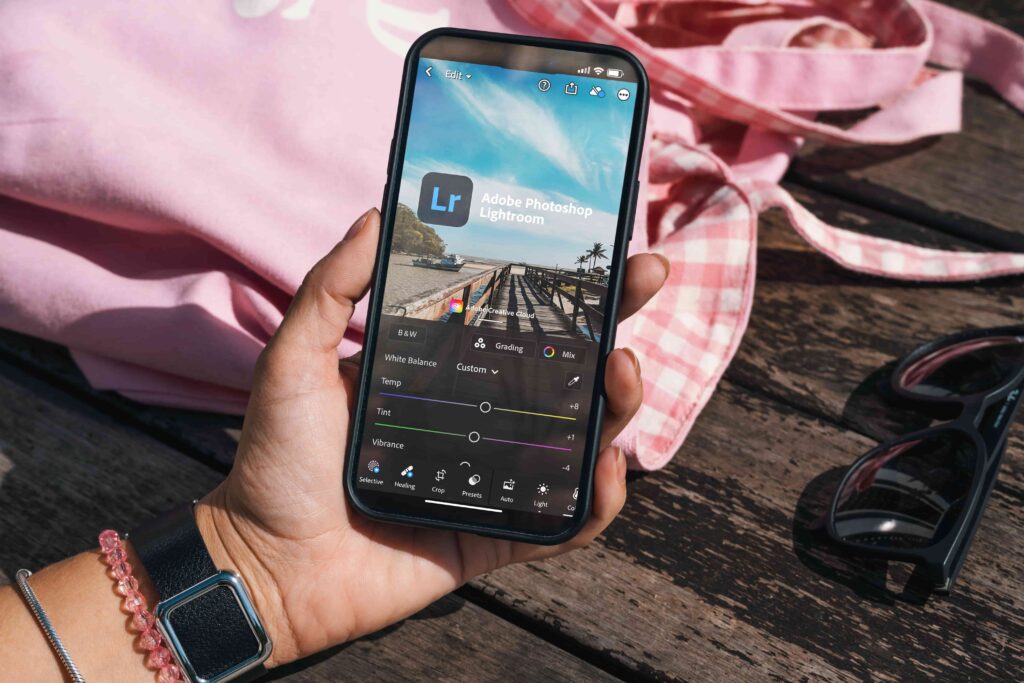Transform your images using just your cell phone

If you're looking to improve your photo editing skills right from your phone, you've come to the right place! We've brought you a complete guide on how to edit photos on your phone.
Nowadays, you no longer need to open heavy software on your computer and can make your images look professional with just a few clicks.
Keep reading to discover tips on how to develop your artistic skills and discover incredible apps for making edits with great ease.

Best Online Yoga Apps
Explore the best online yoga apps with customizable classes and develop your well-being.
Introduction to how to edit photos on your cell phone
As smartphones have evolved, powerful apps offer advanced features like filters, color adjustments, and blemish correction right in the palm of your hand.
Furthermore, the practicality of these apps eliminates the need to transfer photos to the computer, making the process faster and more convenient.
Whether you're a photography enthusiast or a beginner in editing apps, there are a variety of tools to suit all tastes and needs.
Therefore, in addition to presenting the best apps for editing photos on your cell phone and introducing their tools, we will also offer tips on how to improve your editing skills.
How to develop your photo editing skills on your phone
Many people think that image editing is a gift, but we are here to tell you that, just like other skills, this one can also be practiced.
Therefore, there are some simple strategies for those who want to improve their photo editing.
That’s why we’ve put together some tips to make the process of creating and editing images easier for you. Check it out!
- Understand your taste: notice what catches your attention, the colors, aesthetic style, visual effects and feelings that inspire you.
- Search for references: Whether it's classical painters or contemporary artists, training your eye for art can be done even while you're walking down the street.
- Learn: Look for in-depth tutorials on specific effects and editing styles you want to master.
- Practice: Practice is essential to familiarize yourself with the editing process as a whole. Remember that practice makes perfect.
- Study: Look for research on color theory, typography, art history, and other related topics. All of these can serve as a source of inspiration and enrich your knowledge.
- Accept the error: vulnerability in creation is an important step. It is normal to not be satisfied with the initial results. Keep practicing and learning from your mistakes.
Unleash your creativity: the best apps for editing photos on your cell phone

Check out a list of apps below that offer advanced features to transform your images into true works of art.
PicsArt
PicsArt is a photo editing and collage making app that offers a wide variety of tools and effects.
This is one of the most popular photo editing apps for mobile phones at the moment, and allows users to apply filters, add stickers, text, overlays and much more.
Additionally, the app also offers features for digital drawing and painting, making it a complete platform.
Although PicsArt is free, its free version has limited features.
To access all the tools and possibilities of the application, we recommend checking the available paid plans.
VSCO
VSCO stands out for being more than just a photo editing app; it's also a social network!
Recognized for its wide range of filters, this app also offers advanced editing tools.
With it, you can apply filters, adjust exposure, contrast, temperature and other aspects of your photos.
In addition to photo editing, VSCO functions as a social networking platform where users can share their edited photos and view other people's photos.
However, it is not possible to interact directly with other users, only follow them on the platform.
Canva
Canva is an online platform that offers a wide range of tools that go beyond basic editing.
With this application, users can create graphic designs from scratch or from ready-made templates.
On Canva, you can find graphic elements, fonts and much more!
It is a popular tool for individuals and companies who want to produce visual materials and a great solution for those who are not familiar with complex software.
Canva is available for mobile and desktop and is free. However, Canva Pro is where you’ll find the widest range of possibilities.
Photoshop Express
This is an application developed by Adobe that seeks to offer an adapted version of the traditional Photoshop for mobile devices.
As the name suggests, Photoshop Express is a simplified version that is more intuitive to use.
With it, users can perform a variety of edits such as adjusting colors, brightness, contrast, removing imperfections, and more.
Therefore, it is a convenient option for those who want to make quick and simple edits to their photos, without the need to use more complex software.
Finally, Photoshop Express is available as a free download, with the option to access additional features through premium subscriptions.
Adobe Lightroom

Also developed by Adobe, Lightroom is a photo editing application with a wide range of advanced tools.
With it, you can adjust colors, brightness, contrast, exposure and other aspects of images, as well as organize photos into libraries.
The mobile version of Lightroom is more simplified than the desktop version, promising to be compatible with any level of editing, from beginner to advanced.
With this app, you can remove objects, correct imperfections, and perform other elaborate edits with ease.
Top photo editing app tools you need to know
When editing photos on your phone, it is essential to understand the basic tools that editing apps offer.
These features allow you to make adjustments that quickly transform your images. Here are the main tools you need to know about:
- Filters: These are preset adjustments that change the look of your photo with a single tap. They can change color tones, brightness, and contrast. Use filters to add style to your photos.
- Brightness adjustment: Increases or decreases the overall lighting of the photo. This helps improve photos that came out too dark or too bright.
- Contrast: Contrast defines the difference between the lightest and darkest parts of the photo. A good contrast adjustment brings more life and definition to the image.
- Saturation: Saturation controls the intensity of colors. Adjusting saturation can bring out vibrant colors or create a softer, more natural effect.
- Crop: Cropping allows you to remove unnecessary parts of the photo and focus on the main subject. It is ideal for improving framing.
- Temperature: Controls the color balance between warm (yellow) and cool (blue) tones. Adjust the temperature to create different moods in the image.
- Sharpness: Sharpening enhances image detail, making it clearer and more defined. Use it sparingly to avoid overdoing it.
These are basic yet powerful tools that will transform any photo with just a few taps on your phone.
The best features of editing apps that you are not taking advantage of
Photo editing apps have many advanced features that can take your editing to the next level, but which are not always explored by users.
Here are some of the best tools you might not be using:
- Tone curves: Allows you to individually adjust the shadows, midtones, and highlights of an image. This function gives you complete control over the brightness of your photo.
- Selective brush: Tool that allows you to change specific areas of the photo without affecting the rest. Ideal for adjusting the brightness or color of a particular object.
- Lens correction: Corrects distortions caused by camera lenses, such as “fisheye”. This improves the geometry of photos.
- Background blur: Create the bokeh effect to highlight the main subject by blurring the background, giving a more professional look to your photos.
- Object Removal: Some apps allow you to remove unwanted elements from the photo, such as electrical wires, people or shadows, leaving the image cleaner.
- Layered editing: Feature that allows you to superimpose elements and edit different parts of the photo without altering the rest. Essential for more complex montages.
- Gradients: Applying gradients can improve the transition of colors and lights in your photos, creating a smoother, more professional effect.
Using these features can take your edits to the next level, delivering more sophisticated results.

Apps to Increase Cell Phone Volume
Discover the best apps to increase the volume of your cell phone and check out free options for Android and iOS.
Common mistakes when editing photos on your phone and how to avoid them
Editing photos on your phone is easy, but it’s easy to make mistakes, especially for beginners. Here are the most common mistakes and how to avoid them:
- Excessive use of filters: Applying too many filters can make your photo look unnatural. To avoid this, use filters sparingly, adjusting the intensity to maintain a natural look.
- Oversaturation: Increasing the saturation too much makes the colors too intense and unrealistic. Adjust it until the colors are vibrant but natural.
- Too much sharpness: Too much sharpening can cause the photo to lose detail and look pixelated. Apply sharpening lightly.
- Crop the image too much: Cropping the photo too much can compromise the quality and original framing. Make sure to maintain the proper aspect ratio when cropping.
- Forgetting to save copies: When directly editing the original photo, you may lose the original version beyond recovery. Always create copies before editing.
- Using unnecessary effects: Adding effects like vignettes or grain unnecessarily can overwhelm a photo. Use them only when they make sense.
Avoiding these mistakes helps you create more balanced and aesthetically pleasing photos.
How to use custom presets and filters to speed up your edits
Custom presets and filters are powerful tools for streamlining the editing process and maintaining a consistent aesthetic across your photos.
A preset is a predefined set of adjustments, such as brightness, contrast, saturation, and other parameters, that can be applied to a photo with a single click.
This saves time and ensures that your photos maintain a cohesive visual style. They’re especially useful for photographers or influencers who want to create a cohesive social media feed.
You can create your own presets manually, saving the edits you make to a photo, or you can download them from specialized websites that offer ready-made presets.
Many editing applications allow you to save these adjustments and apply them to other images, making it easy to work in batches.
Custom filters, on the other hand, allow for finer adjustments. With them, you can modify the intensity of effects and colors, adjusting the parameters as needed.
Applying these filters to multiple photos at once is an efficient way to keep your workflow going.
Additionally, using presets or batch filters saves time when applying the same adjustments to multiple images, ensuring consistency in editing, especially for professionals who work with large volumes of photos.
These tools are ideal for those looking for a more agile editing process, whether for social media, portfolios or photography projects.
Photo Editing for Social Media: What Works Best for Instagram, Facebook, and More

Editing photos for social media requires different approaches depending on the platform you're posting to.
Each social network has its own peculiarities, and adapting edits for each one can make all the difference in engagement.
On Instagram, the preferred format is square or vertical. Photos with vibrant colors and high contrast tend to attract more attention, due to the visual style of the platform.
Light filters and a feed with uniform aesthetics are recommended to maintain profile consistency.
Additionally, using custom presets makes it easier to create a cohesive visual identity for influencers and brands.
On Facebook, horizontal photos are still more common, and image quality is crucial, as the platform is widely used by diverse audiences.
Focusing on real moments and authentic captures tends to generate more engagement. Here, photos can be a little less edited, maintaining a more natural look.
For Pinterest, vertical format is essential, and images need to be clear and uncluttered.
Soft colors and a clean approach work best, as the platform is all about visual inspiration.
It’s worth investing in montages or collages that help tell a story in a visually appealing way.
On Twitter, speed is the most important factor. Simple images, with little text and a clear focus on the main topic, work best.
Since Twitter is a fast-paced consumption platform, straightforward, well-framed photos are most effective.
How to create creative collages and montages on your cell phone
Creating creative collages and montages on your phone is a great way to express your creativity and tell visual stories in a dynamic way.
Using apps makes it easy to combine multiple photos into an attractive layout.
Many apps offer pre-defined templates where you can insert your images, adjust their positioning and add graphic elements such as text or stickers.
To create a collage, start by choosing a theme or goal. It could be a sequence of moments from a trip, a set of product photos, or even a memory wall.
Select images that match each other in terms of color and style to maintain visual harmony.
You can also play around with photo overlays or use transparencies to give your collage a more dynamic effect.
Tools such as filters, brightness and contrast adjustments can be applied individually to each image within the montage, allowing for personalized adjustments to each element of the collage.
Additionally, try creating a sequential montage, where several photos together tell a story or capture the movement of an action.
Another tip is to add graphic elements, such as icons, frames or even small illustrations, which helps to further personalize your creation.
Not only are these collages fun to create, they also help to engage your audience on social media by offering a creative and unique visual presentation.
Cropping and Framing Techniques: How to Highlight the Subject of Your Photo
Cropping and framing are essential steps in photo editing, especially if you want to highlight the main subject of the image.
The “rule of thirds” is one of the most used techniques to ensure good framing.
In this technique, the image is divided into nine equal parts by two vertical and two horizontal lines.
Positioning the subject of your photo at the intersection points of these lines creates a balanced and attractive composition.
Another important technique is the use of negative space, which is the empty area around the main subject. This helps to keep the focus on the object or person, without distractions.
Negative space also offers a more minimalist effect, ideal for product or portrait photography.
When cropping your photos, be careful not to crop important body parts, such as hands or feet in the case of portraits, or key elements in the case of landscapes.
Maintain the aspect ratio of the image so that it does not lose visual quality or impact.
Additionally, framing can be used creatively, highlighting textures, symmetry or guiding lines that draw the viewer's eye directly to the subject.
Practicing these techniques will help you create more attractive, well-composed images that highlight what really matters in your photo.
How to save and organize your edited photos on your phone
Organizing and saving your edited photos properly is essential to keeping your workflow efficient and ensuring your images are always accessible.
One of the best ways to organize your photos is to create specific folders on your phone.
For example, you can separate your photos by events, such as “Travel,” “Family,” or “Work.” This makes it easier to find the images when you need them in the future.
Additionally, using cloud storage services like Google Photos, iCloud, or Dropbox ensures that your photos are safe and accessible from anywhere.
The automatic backup offered by these platforms prevents you from losing your edits if something happens to your device.
Another tip is to add tags or keywords to your photos.
Many photo apps allow you to add extra information to images, making them easier to search for later.
This is especially useful if you have a large volume of photos and need to locate a specific image quickly.
It's also important to keep your photos organized into albums within the Photos app itself.
For example, you can create themed albums to make browsing easier, such as “Edited photos”, “Photos for social media”, “Professional work”, among others.
This organization ensures that you always have your photos at hand and that you can find them easily, without wasting time searching.
These organization tips will help you keep your photo library clean, organized, and secure, ensuring you never lose your edits.
Key Points: What You Need to Remember
- Apps like PicsArt, VSCO and Adobe Lightroom are powerful tools for editing photos directly on your cell phone, offering filters, adjustments and personalized presets.
- Applications like Canva and PicsArt They are great for creating creative collages and montages, offering a variety of layout options and graphic elements.
- To use filters in moderation It is essential to maintain the naturalness of the photos, avoiding exaggerations in contrast and saturation.
- Custom Presets and Filters allow for quick and consistent editing, making them especially useful for influencers looking to maintain a cohesive style.
- Organize your edited photos creating themed folders and using cloud storage services like Google Photos and iCloud to ensure security.
- Advanced tools such as selective brush and object removal, can enhance your edits, but are little used by many users.
- Avoid common mistakes, such as overdoing the sharpness or saturation, which can compromise the quality and natural look of the photo.
- For social networks, the format and editing style vary. In Instagram, vibrant, vertical photos stand out, while in Facebook, more natural and horizontal images are more effective.
Explore the world with peace of mind: discover travel apps!
In short, editing photos on your phone has never been easier or more accessible, allowing anyone to develop their artistic skills with just a few taps on the screen.
We hope the tips and apps presented in this guide have been helpful to you.
And if you want to explore the world of apps further, check out the next article, where we will present a selection of the best apps to plan and enjoy your trips!
Get ready to embark on this journey with us. Keep reading!

